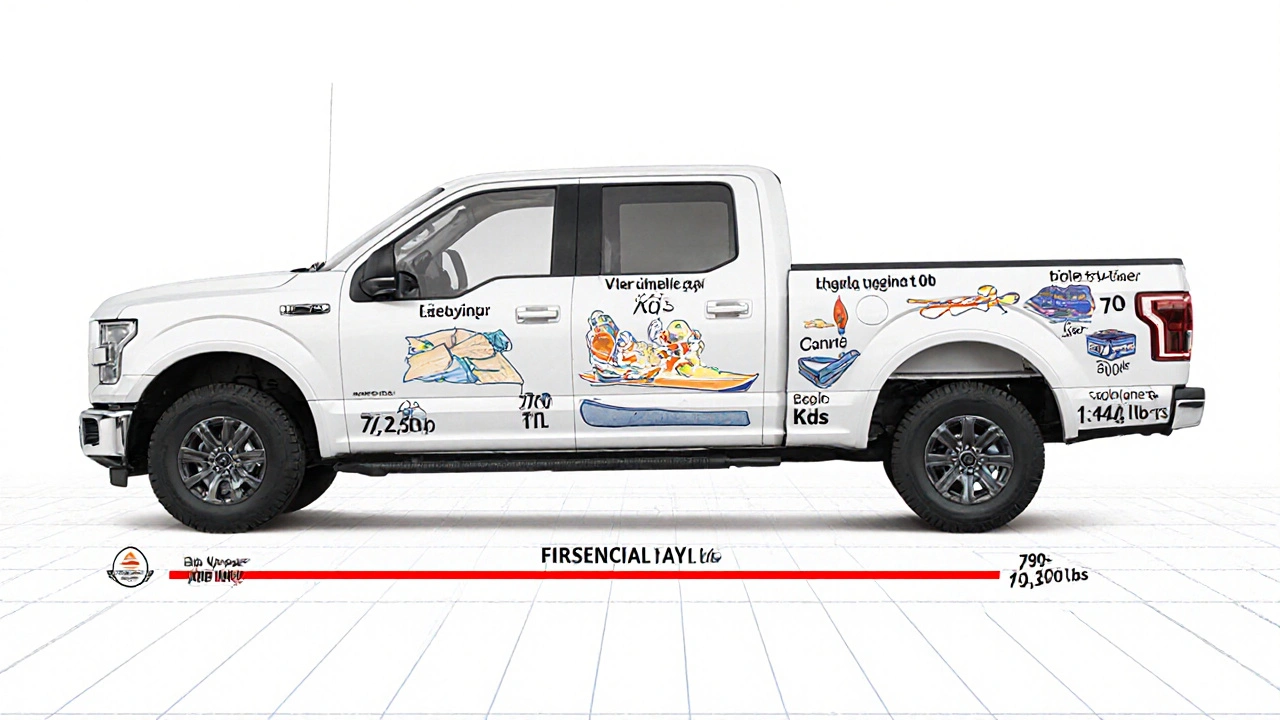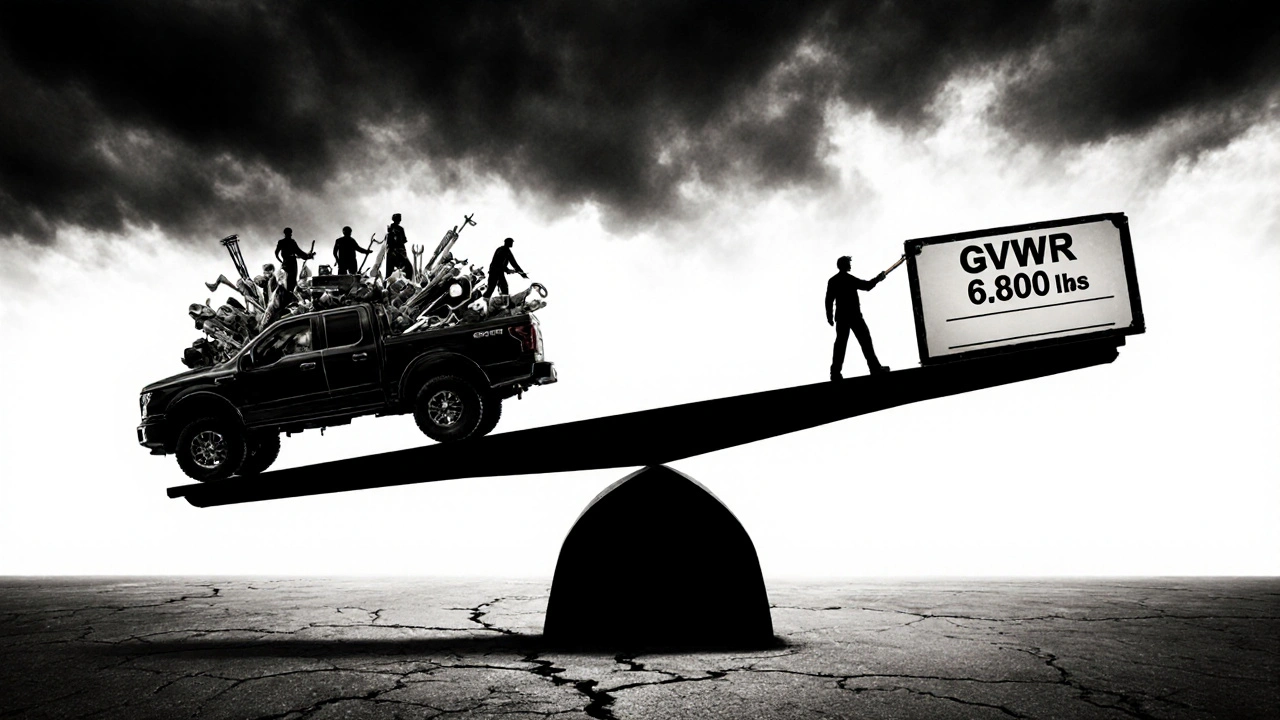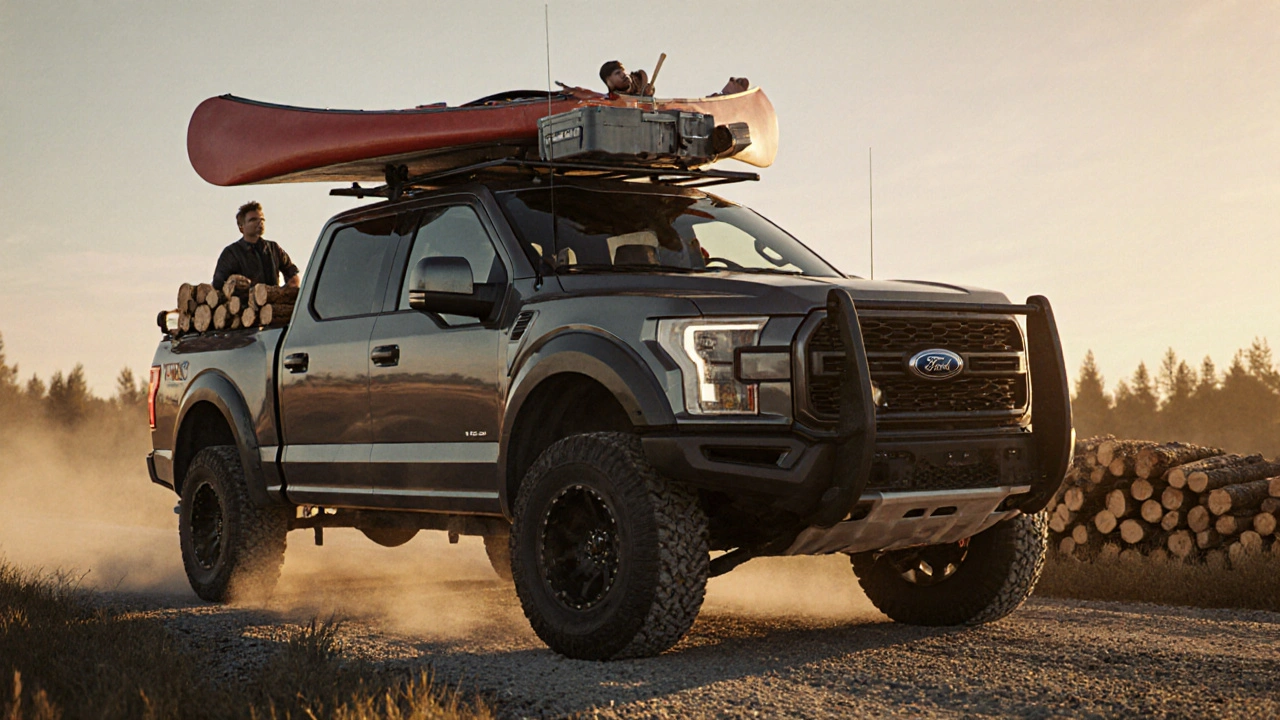Most pickup truck owners think they know how much their truck can carry-until they overload it and end up with a sagging rear end, blown tires, or worse. Payload isn’t just a number on a sticker. It’s the difference between getting the job done safely and ending up in a repair shop. If you’re hauling tools, gear, or materials regularly, you need to understand exactly what your truck can handle-not what the brochure says, but what your real-world setup allows.
What Exactly Is Payload?
Payload is the total weight your truck can carry inside the cab and bed. That includes passengers, cargo, tools, coolers, camping gear, and even the fuel in the tank. It’s not the same as towing capacity. Towing is what you pull behind the truck. Payload is everything you put on top of or inside it.
Every truck has a Gross Vehicle Weight Rating (GVWR)-the maximum safe weight the vehicle can be when fully loaded. Subtract the truck’s curb weight (how much it weighs empty, with fluids and a full tank of gas) from the GVWR, and you get your payload capacity. For example, if your truck’s GVWR is 6,800 pounds and its curb weight is 4,700 pounds, your payload capacity is 2,100 pounds.
But here’s the catch: that 2,100 pounds isn’t all yours to use. It’s already reduced by the weight of the driver, passengers, and anything factory-installed like a bed liner, toolbox, or hitch. If you’ve added aftermarket accessories-roof racks, winches, heavy-duty bumpers-you’re eating into that number before you even load a single bag of gravel.
Real-World Payload Breakdown: A Day in the Life
Let’s say you drive a 2025 Ford F-150 XLT with a 3.5L EcoBoost engine, crew cab, and 6.5-foot bed. Ford lists its max payload at 2,230 pounds. Sounds impressive, right? But let’s look at what actually fits in that number.
- Driver: 180 pounds
- Passenger: 160 pounds
- Two kids in back: 120 pounds each = 240 pounds
- Full tank of gas: 170 pounds
- Toolbox in bed: 80 pounds
- Bed liner: 60 pounds
- Canoe on roof rack: 50 pounds
- Firewood in bed: 300 pounds
- Backpacks, coolers, tools: 200 pounds
Add those up: 180 + 160 + 240 + 170 + 80 + 60 + 50 + 300 + 200 = 1,440 pounds used. That leaves you with 790 pounds of available payload.
Now imagine you need to haul 1,000 pounds of gravel for a landscaping job. You’re over by 210 pounds. That’s not just a little extra-it’s enough to strain your suspension, reduce braking performance, and increase tire wear. And if you’re driving on rough roads or hills, that extra weight could cause overheating or even suspension failure.
Why Factory Numbers Don’t Tell the Whole Story
Truck manufacturers list maximum payload numbers under ideal conditions: one driver, no passengers, empty bed, no accessories, and a full tank of gas. That’s not your reality. Most buyers don’t realize that payload capacity drops the moment they add options.
For example, a 4x4 model weighs more than a 2WD version because of the transfer case, heavier axles, and reinforced frame. A long bed adds weight over a short bed. Leather seats are heavier than cloth. A sunroof adds 50+ pounds. Even the type of tires you choose matters-LT (light truck) tires are stronger but heavier than P-metric tires.
Look at your truck’s door jamb sticker. It shows the actual payload capacity for your specific vehicle, based on its exact build. That’s the number you need to trust-not the one on the website or in the brochure. If your sticker says 1,950 pounds, that’s your limit, no matter what Ford’s marketing says.

How to Calculate Your Real Payload Capacity
Here’s how to find your true payload limit:
- Find your truck’s GVWR on the door jamb sticker.
- Take your truck to a weigh station (truck stops or CAT scales work). Weigh it empty-with a full tank of gas, no cargo, no passengers.
- Subtract the empty weight from the GVWR. That’s your real payload capacity.
- Now list everything you regularly carry: people, tools, gear, accessories. Add their weights.
- Subtract your total load from your real payload capacity. The result is your remaining buffer.
If your buffer is under 200 pounds, you’re running on the edge. If it’s negative, you’re overloaded. That’s not a suggestion-it’s a safety issue.
Common Overload Traps
Here are the most common ways people accidentally overload their trucks:
- Assuming the bed can hold anything. A 6-foot bed might look big, but a cubic yard of wet sand weighs over 3,000 pounds. You can’t fit that in any pickup without serious damage.
- Ignoring passenger weight. Five adults in a crew cab? That’s 800+ pounds right there. Add kids and gear, and you’re halfway to your limit before you even open the tailgate.
- Adding accessories without recalculating. A winch adds 100 pounds. A rooftop carrier adds 60. A custom exhaust adds 30. They all add up.
- Using the wrong tires. Stock tires might be rated for 2,000 pounds per axle. Upgraded LT tires might handle 3,000, but if your suspension isn’t upgraded, you’re still limited by the frame.
- Thinking “it’s just a little over.” Exceeding payload by 10% increases stopping distance by 20%. It also puts stress on the rear axle, differential, and springs. That’s not a one-time thing-it’s cumulative wear.

What Happens When You Go Over
Overloading doesn’t just break parts-it breaks safety. Here’s what you risk:
- Brake fade. Extra weight means more heat in the brakes. They get less effective, especially on hills.
- Reduced steering control. A sagging rear end shifts weight forward, making the front end feel light and unresponsive.
- Tire blowouts. Underinflated or overloaded tires generate excess heat. A single blowout at highway speed can be deadly.
- Suspension failure. Springs and shocks aren’t designed for constant overload. They wear out faster or snap.
- Insurance issues. If you’re in an accident while overloaded, your insurer can deny your claim.
There’s a reason commercial haulers use weight scales before leaving the yard. It’s not bureaucracy-it’s survival.
How to Increase Payload Capacity (Safely)
You can’t magically add pounds to your truck’s payload rating. But you can optimize what you carry:
- Lighten your load. Use lighter materials. Plastic toolboxes instead of steel. Aluminum ladders instead of wood. Remove unnecessary gear.
- Redistribute weight. Keep heavy items low and centered. Don’t pile everything in the back corner.
- Upgrade suspension. Air helper springs or load-leveling shocks can help with sag, but they don’t increase the legal payload limit-they just make the ride safer within it.
- Use a trailer. If you regularly haul over 1,500 pounds, consider a utility trailer. It’s cheaper than replacing a broken axle.
- Choose the right truck. If you need more payload, look at 3/4-ton trucks like the Ford F-250, Ram 2500, or Chevrolet Silverado 2500. They often have payload capacities over 4,000 pounds.
Final Rule: Always Weigh It
The only way to know your real payload is to weigh it. Find a truck scale-many are at feed stores, gravel yards, or CAT scales along highways. Pay the $10-$15 fee. Weigh your truck empty. Then weigh it fully loaded. The difference is your actual payload.
If you haul the same things every week, write down the weights. Keep a checklist: driver, passengers, fuel, tools, gear. Update it when you add or remove items. Treat it like a budget-you wouldn’t spend more than you earn. Don’t load more than your truck can carry.
Trucks are built tough, but they’re not magic. The numbers on the sticker are limits, not suggestions. Respect them. Your tires, your brakes, and your life depend on it.
How do I find my truck’s actual payload capacity?
Look at the sticker on the driver’s side door jamb. It lists your truck’s Gross Vehicle Weight Rating (GVWR) and the actual payload capacity for your specific configuration. That number is more accurate than anything in the owner’s manual or online.
Can I increase my truck’s payload capacity with aftermarket parts?
No. Upgrading suspension, tires, or axles doesn’t change the manufacturer’s payload rating. Those upgrades help your truck handle the load better and reduce sag, but they don’t legally increase the weight limit. The GVWR is set by the manufacturer based on frame, brakes, and cooling system limits.
Is payload the same as towing capacity?
No. Payload is everything inside and on the truck-people, cargo, fuel. Towing is what you pull behind it with a hitch. Both use up your truck’s total capacity. Adding a heavy trailer reduces the weight you can carry in the bed because the combined weight must stay under the GVWR.
Why does my truck sag when I load it?
Sagging means you’re exceeding the suspension’s ability to support the load. It’s a sign you’re either overloaded or your suspension is worn out. Even if the total weight is under the GVWR, uneven weight distribution or weak springs can cause sag. Weigh your truck and check your suspension components.
Should I use a trailer instead of loading the bed?
If you regularly haul more than 1,500 pounds, a trailer is safer and smarter. It keeps weight off your truck’s frame, reduces wear on brakes and suspension, and gives you more control. A 5x8 utility trailer can carry 2,000+ pounds and costs less than replacing a damaged axle.

Amanda Ablan
November 4, 2025 AT 23:42I used to think my F-150 could handle anything until I loaded up for a camping trip and the rear end touched the tires. Weighed it at a CAT scale and turned out I was 300 lbs over. Scary stuff. Now I always check before I go.
Thanks for the breakdown - this should be mandatory reading for every truck owner.
Meredith Howard
November 5, 2025 AT 02:54It is astonishing how many people confuse payload with towing capacity and then wonder why their truck handles like a brick wagon
the door jamb sticker is the only source that matters
brochures are marketing fiction
fact is fact
weight is weight
Yashwanth Gouravajjula
November 6, 2025 AT 18:52India has many pickup users who overload for profit. No scales. No awareness. Many accidents. This post is needed everywhere.
Kevin Hagerty
November 7, 2025 AT 13:32Wow someone actually wrote a novel about not putting too much stuff in a truck
congrats you discovered gravity
next week’s article: don’t drive your truck into a wall
also why is everyone so scared of 200 extra pounds
my 2003 Ranger carried 2k lbs of bricks and still started
maybe your truck is just weak
Janiss McCamish
November 8, 2025 AT 01:45That 790 lbs buffer? That’s your safety net. If you’re below 200, you’re gambling. No excuses.
And yes - your roof rack adds weight. Yes, your kids count. Yes, your toolbox matters.
Stop guessing. Weigh it.
Richard H
November 8, 2025 AT 23:43Y’all worry too much. Real Americans don’t weigh their trucks. We load ‘em till the bed’s full and the suspension screams. That’s how you know it’s ready.
Truck is American. Payload limit? That’s a liberal myth.
My uncle hauled 4k lbs of gravel in a half-ton. Still runs. You just gotta have guts.
Kendall Storey
November 9, 2025 AT 06:07Bro this is the most underrated topic in truck culture. Everyone talks about horsepower and lift kits but ignores the actual chassis limits.
Here’s the real talk: your truck’s payload isn’t a suggestion - it’s a hard limit baked into the frame, brakes, and cooling system.
Upgrading springs doesn’t change that. It just makes the sag less visible.
Use a trailer. It’s cheaper than a new differential.
Ashton Strong
November 9, 2025 AT 12:27This is an exceptionally well-researched and thoughtful piece. Thank you for taking the time to clarify such critical safety information.
Many owners are unaware that factory payload ratings are based on minimal configurations, and the moment they add even a floor mat, the available capacity diminishes.
It is my sincere hope that this information reaches every truck driver - especially those who haul for work or family trips.
Safety is not optional. It is fundamental.
Steven Hanton
November 9, 2025 AT 19:32I appreciate the emphasis on weighing the truck rather than trusting the brochure. I did this last year after noticing my rear tires were wearing unevenly.
Turned out I was carrying 180 lbs over - mostly from a toolbox I forgot about.
Now I keep a printed checklist taped to my visor. Small habit, big difference.
Thanks for the reminder that responsibility matters more than capacity.
Pamela Tanner
November 10, 2025 AT 08:52Correct punctuation and grammar are essential when discussing safety-critical information. This post is clear, accurate, and properly structured.
For example: 'Payload is the total weight your truck can carry inside the cab and bed.' - no ambiguity, no error.
Many online sources misuse terms like GVWR and curb weight. This is a model of clarity.
Kristina Kalolo
November 11, 2025 AT 03:04I never thought about how much my roof rack adds. Just assumed it was 'free' weight. Now I'm gonna weigh everything. Thanks.
ravi kumar
November 12, 2025 AT 04:52My brother uses his Tata pickup to carry bricks. He says 'it works fine'. I told him this. He laughed. But now he checks the sticker. Small change. Big safety.
Megan Blakeman
November 12, 2025 AT 16:31This is so important!!! I used to think my truck was a magic box that could hold everything... until the back dipped so low I thought I'd lose my tail lights... now I weigh everything... and I keep a little notebook... it's like a budget for my truck... and I feel so much safer... 😊
Akhil Bellam
November 13, 2025 AT 01:47How quaint. A 2025 F-150 with a payload of 2,230 lbs? That’s barely a mid-tier utility vehicle in the real world. Real work trucks - the ones built for actual labor - have 4,000+ lb capacities. You’re still playing with toy trucks while the rest of us haul concrete and steel.
Also - you didn’t mention diesel torque curves. That’s amateur hour.
And why are you still using P-metric tires? That’s just asking for trouble. LTs are non-negotiable. Your entire post reads like a brochure written by someone who’s never loaded a pallet.
Amanda Ablan
November 13, 2025 AT 14:27@Kevin Hagerty - I get it, you think toughness means ignoring physics. But when your rear axle snaps on a highway and you’re the one in the hospital, no one’s gonna care how 'American' your driving was.
My cousin did exactly what you’re bragging about. Broke his spine. Truck totaled.
Respect the machine. Or don’t. But don’t pretend your ego is safer than science.